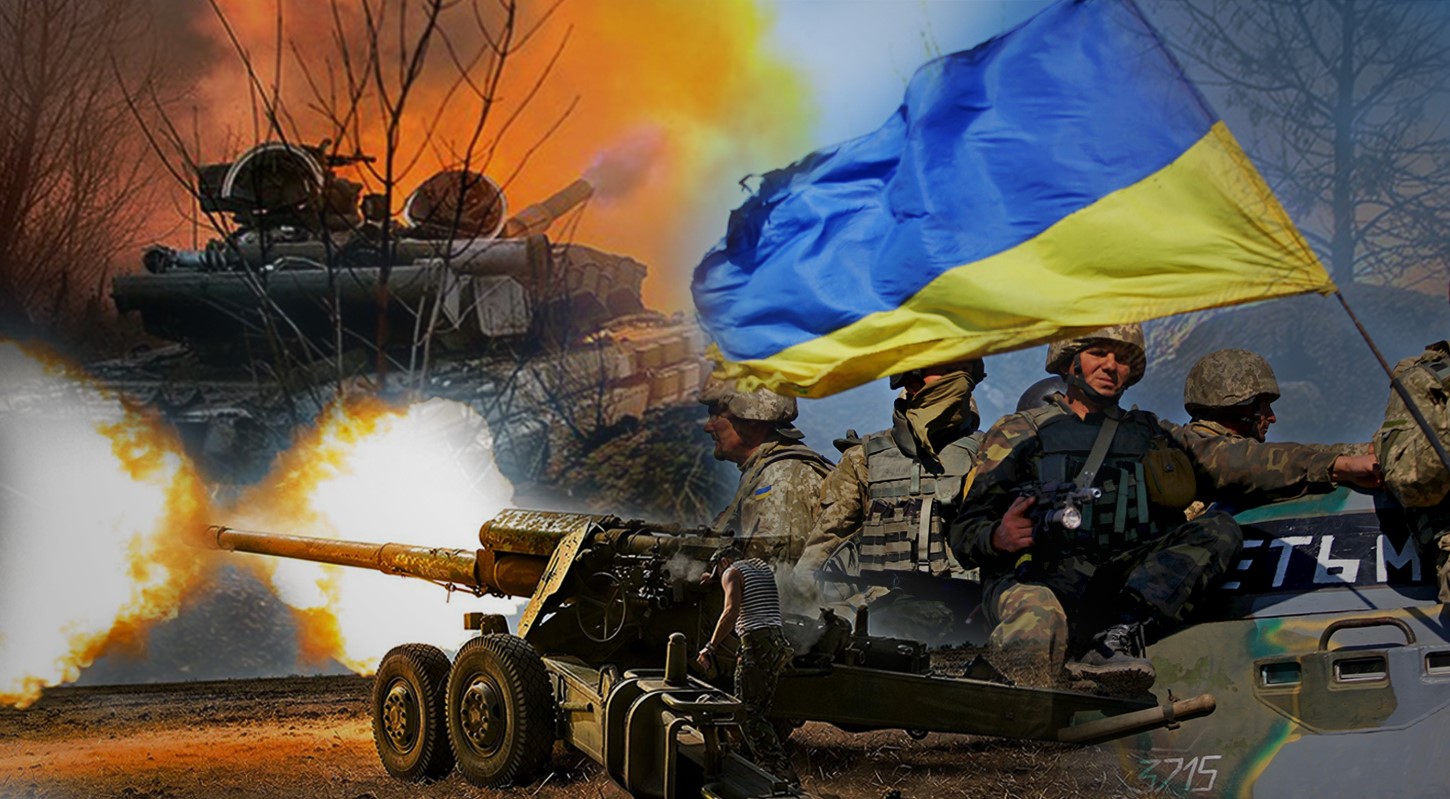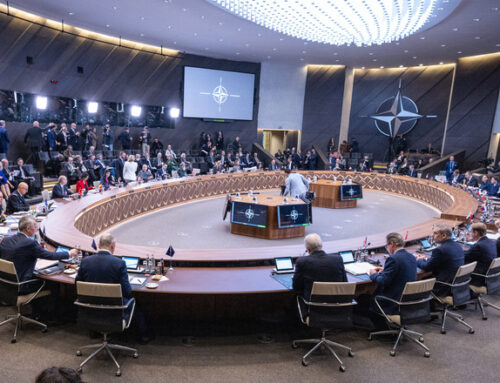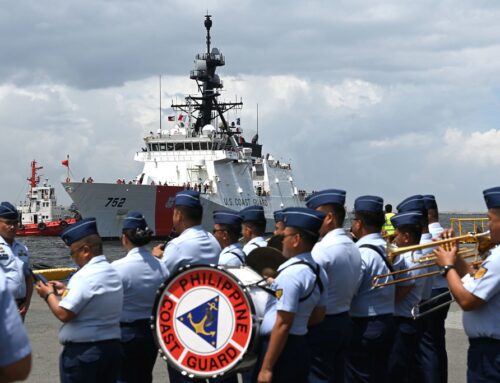War in Ukraine – weekly update (25.02-03.03.2023)
Autor foto: Domena publiczna



War in Ukraine – weekly update (25.02-03.03.2023)
Autor foto: Domena publiczna
War in Ukraine – weekly update (29.04-05.05.2023)
Autor: Sebastian Czub
Opublikowano: 5 maja, 2023
Bakhmut
Despite recent Russian advances Ukrainian forces continue to defend Bakhmut. This week saw the collapse of the Ukrainian defences along the railway line in the western part of the city. Russian assaults from the north have successfully threatened Ukrainian positions which led to a loss of a large part of western Bakhmut. Ukraine now holds less than 10% of the city, concentrating their defences around Yuvileina street, located in the western outskirts, which leads to the Khromove “Road of Life”. While the “Road of Life” is no longer passable due to the proximity of Russian forces, it still serves as an important defensive position, with a large network of fortifications based on it. At this stage it is most probable that Ukrainian forces are trying to slow down Russian advances while conducting an organised retreat from the city. This can be supported by two observations. Firstly, Ukrainian forces have begun employing the scorched earth tactics, destroying buildings, positions, and infrastructure that could be useful to the enemy, signalling their intention to abandon the area for a significant amount of time.i Secondly, the Ukrainians have deployed special operations forces into Bakhmut, which are better equipped and trained – both of which are needed to conduct difficult operations like the fighting withdrawal or planned destruction of critical targets – in this case city infrastructure.
These observations might also be indicative of the future operations of the Ukrainian armed forces. Firstly, the organised withdrawal from Bakhmut would suggest that Ukrainians have prepared another defensive line to which they will relocate. It is possible that Ukrainians hope to use the hills to the west of Bakhmut as the backbone of their defences. These hills, overlooking the city, have been in heavy use for the past several months, serving primarily as artillery positions. This means that a considerable network of fortification and support structures is already in place in this area. Furthermore, the hills grant Ukrianians high ground, which is very difficult to assault, with Russian troops having limited cover and concealment. Thus, even when the Russians capture Bakhmut they will be faced with another comprehensible defensive line that will be extremely difficult to break through, while at the same time possessing forces that have been heavily depleted from the fighting in Bakhmut itself. The only issue for Ukrainian forces might be the direction of Hryhorivka and Orikhovo-Vasylivka where the Russians have captured a number of hills and high grounds, thus potentially eliminating the terrain advantage and creating an opportunity for further offensive operations.
Kherson
Ukrainian and Russian forces have intensified their operation in the Kherson region, with both sides entering into an artillery duel. Ukrainians are continuously targeting Russian strongpoints, troop concentrations, supply lines and artillery positions. On the other side Russians have brought in greater numbers of artillery pieces engaging in counter battery fire. Ukrainians have been recorded to carry out 100 fire missions with Russians conducting roughly 110 artillery and missile strikes, firing at least 550 shells on May 3rd alone.ii The increased activity in the region suggests its increasing significance. It is possible that last week’s incursions by Ukrainian forces on the eastern bank of the Dnieper have been a preparation for a larger offensive effort in the area. Russian sources have grown significantly concerned over the possibility of Ukrainian amphibious assault across the Dnieper. This led to increasing efforts in the preparation of defensive positions all the way from the frontlines to Crimea. There is a possibility that these actions by the Ukrainian armed forces are part of an informational campaign aimed to confuse Russians as to the direction of the upcoming counteroffensive. Ukrainian forces have engaged in similar campaigns all along the frontlines, however the increased use of artillery ammunition while experiencing shortages might suggest otherwise. Thus, it is increasingly possible that Ukraine seeks to conduct major operations in the Kherson region.
Other sectors of the frontline
The situation in other parts of the frontline remains relatively stable, with both sides conducting routine operations. One noteworthy event is a presumed Russian informational campaign centred on the Zaporizhia region. Vladimir Rogov, the occupational authority of the Russian controlled part of the Zaporizhia Oblast stated that Ukrainian forces have begun their spring offensive.iii According to him Ukrainian troops have launched a major assault south of Orikhiv, and that they have been defeated, with Russian soldiers driving them back to Ukrainian lines. This story has no credible confirmation. It is possible that this statement was a propaganda campaign aimed to boost the morale of Russian soldiers, while at the same time hoping to sow confusion among the Ukrainians potentially causing them to act and reveal plans for the upcoming offensive.
Attack on the Kremlin – Real Deal or a Clever Maskirovka
On May 3rd footage showing a drone exploding over the building of the Kremlin Senate Palace in Moscow has surfaced across social media channels. The Kremlin has accused Ukraine of conducting the strike, calling it an “orchestrated terrorist attack” and framing it as an attempt on Putin’s life.iv Though, according to the Kremlin Vladimir Putin was not present in the Kremlin at that time, and has therefore not suffered any injuries. In response to the Russian accusations several Ukrainian officials, and even the Ukrainian President Volodymyr Zelensky, have denied Ukrainian involvement. There is however, some merit to Russian accusations as Ukrainian armed forces possess the equipment necessary to launch such a strike. Furthermore, according to the supposed leaked secret US document on the war in Ukraine, Ukrainians have been planning a strike into Russia, which was called off only at the behest of the US. As stated in the document Maj. Gen. Kyrylo Budanov, the head of the country’s military intelligence directorate, the HUR, instructed one of his officers “to get ready for mass strikes on 24 February … with everything the HUR had,”.v While the target of this strike was supposed to be the relatively close Russian Black Sea port city of Novorossiysk, Ukrainian equipment is capable of striking as far as Moscow. Furthermore, according to the leak the strike wasn’t entirely cancelled but only postponed at Washington’s request. Russian accusations therefore have a number of arguments speaking in their favour.
On the other hand however, there is a significant basis for the argument that the drone attack has been orchestrated by Russia itself as part of a maskirovka. First thing worth noticing is the footage itself. As can be seen from the video the drone detonated over the building rather than upon impacting it.vi The explosion itself was also relatively small, thus very improbable to damage anything significant. Another key point worth addressing is the response from the Russian air defence, which claims to have shot down the drones, though this is not visible in the footage.vii Russian air defence is extremely extensive and comprehensive, it is the reason why Ukrainian air force operations are very limited, with aircraft and helicopters flying at very low altitudes and very rarely if ever operating inside Russian held territory. One good example to note here is the Ukrainian Bayraktar drone fleet, which suffered heavy losses at the hands of Russian air defence and has now been largely dormant or used to patrol controlled airspace. As a counterpoint one might argue that Russia is using the majority of its air defences in Ukraine, thus potentially leaving targets within Russia less defended. However, over the last several months Russia has made a show of installing further air defences in Moscow, sometimes even atop key buildings, like the air defence system on the roof of the Ministry of Defence. These observations point to the idea that Ukrainian drones would be extremely improbable if not outright impossible to enter Moscow airspace and strike at one of the most critical and defended targets in Russia, thus suggesting that the drones were launched and self-destructed by Russia over the Kremlin as part of a maskirovka.
It is possible that the drone strike has been orchestrated by Russia itself to create favourable conditions for an escalation of the war in Ukraine. Since the start of the war Russia has been struggling to maintain sufficient troop numbers in Ukraine, using recruitment schemes and private military companies like Wagner to plug the gap. In the wake of the Ukrainian counter offensive in autumn 2022 Russia conducted a desperate partial mobilisation to reinforce decimated formations and maintain the war effort. The call up was necessary but also extremely unpopular, which led Russia to change track. Thus, for the last several months Russia has been desperately trying to boost the recruitment of soldiers for the war in Ukraine, with additional PMCs, volunteer battalions, and coercion of citizens into contract service. This method has also proven ineffective however, which may have led Russia to reconsider general mobilisation. In the span of the last few months Moscow has been intensely working on smoothening and improving processes for mobilisation. According to Russian sources pay has been standardised, equipment issues are being tackled, new training modernisations are being put into place, and quite importantly the conscription process itself has been modernised. The new system allows for an electronic conscription notification, thus allowing military commissariats to call up draftees without having to locate them and hand in a hard copy of the notice.viii Those who don’t show up within the allotted time are subject to fines and further legal action, as well as prohibition to conduct certain activities like driving a car, purchasing estate, or owning a business. The drone strike on the Kremlin can and might serve as rousing patriotic and nationalistic zeal, but most importantly it can serve to officially declare war on Ukraine and conduct general mobilisation. This would grant Russia hundreds of thousands of potential soldiers that can be used to offset the upcoming Ukrainian counteroffensive and win the war of attrition. While the process to train and equip these new soldiers might take significant amounts of time it will allow Russia to maintain a steady supply of reinforcements and numerical superiority over Ukraine. What is worth noting also is that the declaration of war would allow Russia to use the annual spring conscripts in combat. As at least a portion of them have entered training, Moscow could soon have access to as much as 147,000 additional soldiers with many more on the way.ix The declaration of war will be one the most dire scenarios for Ukraine, which will have to face an increasingly powerful enemy committed to a fight to the very end.
Conclusion
As the Russians are ever closer to capturing Bakhmut in its entirety, Ukrainians are close to launching their spring counter offensive. In the midst of these events the Kremlin has been attacked by drones, with Russia swift to accuse Ukraine of the attack. While the truth in this matter will be difficult to discover, it is most probably inconsequential. The Kremlin might use the incident to formally declare war on Ukraine, transitioning from the Special Military Operation into a full out war. This would allow the Russians to announce general mobilisation, conscripting hundreds of thousands of soldiers in a bid to win the war of attrition against Ukraine. The coming weeks could be very significant in determining the course of the war in Ukraine.
i Karolina Hird et al., “Russian Offensive Campaign Assessment, May 3, 2023”, Press ISW, May 3, 2023, https://understandingwar.org/backgrounder/russian-offensive-campaign-assessment-may-3-2023.
ii Shane Harris and Isabelle Khurshudyan, “At U.S. behest, Ukraine held off anniversary attacks on Russia”, The Washington Post, April 24, 2023, https://www.washingtonpost.com/world/2023/04/24/discord-leaks-moscow-strikes-ukraine/.
iii Karolina Hird et al., “Russian Offensive Campaign Assessment, May 3, 2023”, Press ISW, May 3, 2023, https://understandingwar.org/backgrounder/russian-offensive-campaign-assessment-may-3-2023.
iv Will Vernon, “Analysis: Kremlin drone attack is highly embarrassing for Moscow”, BBC News, May 4, 2023, https://www.bbc.com/news/world-europe-65476085.
v Pjotr Sauer and Dan Sabbagh, “Kremlin drone incident: Zelenskiy denies Russian claim Ukraine attempted to kill Putin”, The Guardian, May 4, 2023, https://www.theguardian.com/world/2023/may/03/russia-accuses-ukraine-of-trying-to-kill-vladimir-putin-with-kremlin-drone-strike.
vi Pjotr Sauer and Dan Sabbagh, “Kremlin drone incident: Zelenskiy denies Russian claim Ukraine attempted to kill Putin”, The Guardian, May 4, 2023, https://www.theguardian.com/world/2023/may/03/russia-accuses-ukraine-of-trying-to-kill-vladimir-putin-with-kremlin-drone-strike.
vii Dmitri, Twitter, April 13, 2023, https://twitter.com/wartranslated/status/1646491733742477313.
viii “Bill on electronic military summonses seeks to streamline enlistment system — Kremlin”, TASS Russian News Agency, April 12, 2023, https://tass.com/politics/1603091.
ix President of the Russian Federation Vladimir Putin, ”Decree of the President of the Russian Federation of March 30, 2023 No. 220 “On the conscription in April – July 2023 of citizens of the Russian Federation for military service and on the dismissal from military service of citizens undergoing military service on conscription””, Chancellery of the President of the Russian Federation, March 30, 2023, http://publication.pravo.gov.ru/Document/View/0001202303300022?index=0&rangeSize=1.






